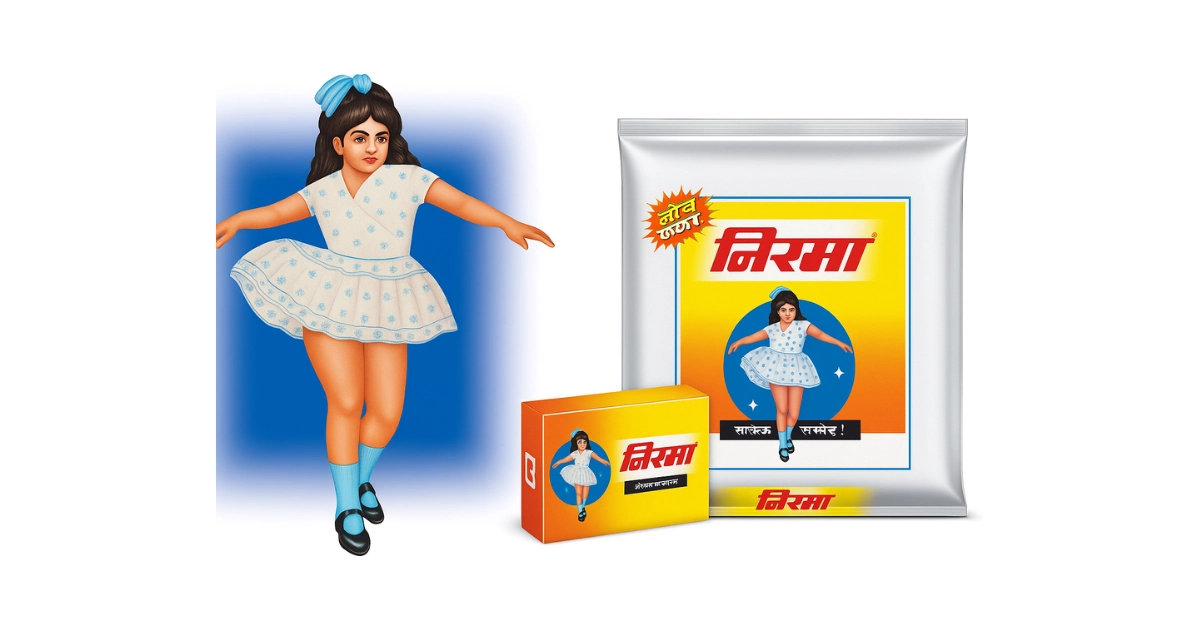Every time I pass by Nirma University on the outskirts of Ahmedabad, a wave of quiet nostalgia washes over me. It isn’t the imposing gates or the manicured campus that stirs me. It’s the name, Nirma, bold and simple, etched on the stone like it once was etched on our own childhoods.
That name doesn’t just belong to a university. It belongs to a memory. A melody. A moment.
And just like that, I’m no longer someone interested in analyzing a corporate pivot. I’m a child again, sitting cross-legged on the cold, mosaic floor of our ancestral home, eyes glued to a flickering black-and-white EC TV set, the kind with knobs that clicked like time itself.
And there it is, that jingle:
Washing powder Nirma, Washing powder Nirma, Doodh si safedi Nirma se aaye...
A girl in a spotless white frock pirouettes on the screen, holding the packet with pride, her dress almost glowing. You didn’t just hear it, you felt it. In homes with brass buckets and charcoal-ironed shirts, in alleys where children played with rubber tyres and handmade cricket bats, Nirma wasn’t a brand but a hope that smelled like soap.
In rural India, Nirma was not a product. It was a promise of dignity through cleanliness. Mothers, aunts, grandmothers - women who budgeted every paisa - found an ally in Nirma. Surf was for the rich. Nirma was for the masses.
And yet, somewhere between then and now, the jingle stopped playing. The girl stopped twirling. The packets stopped piling up in the kitchen drawers. What happened?
Nirma: When Disruption Danced into the Mainstream
The story of Nirma begins in the 1960s with Dr. Karsanbhai Patel, a chemist in Gujarat. He began blending his detergent in his backyard and selling it door-to-door on his bicycle for ₹3 per kilogram. At the time, the market leader, Surf (by Hindustan Lever), was priced at over ₹13.
It was an audacious act. Not backed by distribution networks or marketing agencies. Just a man, his product, and his bicycle. Yet, what Dr. Patel did was no less than what Sam Walton did in rural America with Walmart. He identified the underserved, the unspoken-for, and made them feel seen.
India in the ’70s and ’80s was still emerging from the haze of post-Independence shortages. Clean clothes were a luxury in many homes. Nirma changed that. It gave millions the ability to wash with pride. The formula wasn’t perfect, but it was effective. It gave “doodh si safedi” (milk-like whiteness) to those who had never imagined that such a thing was possible.
The brand didn’t just grow. It exploded. By the mid-1980s, Nirma had overtaken Surf by sheer volume. Its marketing became legendary. Its packaging, with the iconic girl in white, became as recognizable as the national flag in some parts of India. It was the first true example of bottom-of-the-pyramid marketing, before it was ever theorized in B-school classrooms.
The Perils of Standing Still: Why Nirma Faded
But markets, like memories, move on. And Nirma, once the metaphor for detergent in every Hindi-speaking home, began to fade.
Why?
The answer lies not in economics alone, but in culture and aspiration.
1. The Trap of Cost Leadership
Nirma’s biggest strength, its low price, became its limitation. As India liberalized in the 1990s, middle-class incomes rose. People no longer wanted just white clothes. They wanted fragrant, soft, stylish ones. Competitors like HUL’s Surf Excel and P&G’s Ariel began launching premium variants, ones that innovated with enzymes, stain removers, and child-friendly messaging. Nirma, meanwhile, didn’t change its core formula or upgrade its brand perception.
It’s the story of Kodak, which invented digital photography but stuck with film. Or BlackBerry, which clung to physical keyboards as touchscreens took over. Nirma stopped evolving.
2. Frozen in a Time Capsule
The girl in the white frock kept twirling, but the world around her changed. Design became minimal, packaging became aspirational, and brand stories moved from jingles to emotions. But Nirma’s narrative remained stuck in the 1980s.
In an era where Amul’s topical ads kept the brand fresh, and Parle-G adapted quietly to modern packaging while preserving its identity, Nirma lost the plot. It mistook nostalgia for strategy.
3. The Missed Retail Shift
As India’s retail moved from kirana stores to supermarkets and e-commerce platforms, marketing aspects like shelf placement, influencer visibility, and digital advertising became vital. HUL adapted. Nirma didn’t. It remained strong in rural and semi-urban areas but never cracked modern retail or online platforms.
The Cement of Reinvention: Nirma’s Second Life
But just when the business world began writing Nirma’s obituary, the brand pulled off a silent and spectacular pivot.
In 2016, Nirma acquired Lafarge India’s cement business in a $1.4 billion deal. Later, it bought Emami Cement and merged them under the brand Nuvoco Vistas, which today is one of India’s top cement producers.
It also doubled down on its core strength in chemicals, becoming a leading player in soda ash and detergent intermediates, supplying to other FMCG (fast-moving consumer goods) players and manufacturers.
This was Nirma’s IBM moment. It marked a shift from the front-end consumer space to the back-end industrial and infrastructure sector. Like IBM pivoting from personal computers to enterprise software, or Nokia turning into a telecom infrastructure firm, Nirma transitioned from soap suds to cement dust. Unseen, but not unsuccessful.
The Bigger Picture: A Mirror to Indian Business
Nirma’s story is not just about one company. It is about Indian capitalism itself.
It captures the first-generation, entrepreneurial hustle that defined post-Independence India. It reflects the plateau of mid-sized, family-run firms that struggled with liberalization. And it also embodies the silent pivot to B2B and infrastructure, a sector less glamorous but more stable.
Where many brands tried and failed to stay relevant - like Hamam, Cibaca, Liril - Nirma chose reinvention over resurrection.
The Girl Still Twirls, But in a Different Dress
As I look again at the Nirma University signage while passing by, I realize something.
That girl in white still twirls. Not on TV screens now, but in cement trucks rumbling across construction sites. In chemical plants running silently in Gujarat. In a university that carries the name of a man who disrupted India’s most mundane yet essential routine - doing laundry.
Yes, the jingle may have stopped playing. But in some corners of India, it still echoes.
And in boardrooms and balance sheets, Nirma didn’t fade. It transformed.








